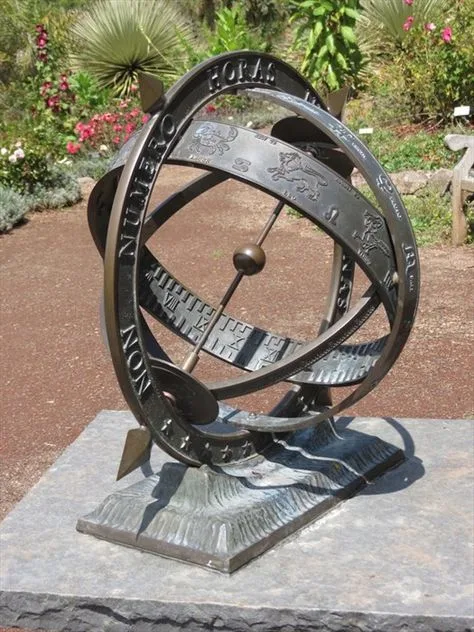A sundial is an antiquated device that tells the time of day by using the sun's location. Since there is evidence that sundials have existed since ancient civilizations, they are frequently regarded as the oldest type of timepiece.
Describe the Sundial Clock. A sundial clock is a particular kind of sundial that marks the time of day by using the sun's location in the sky. More complex or sophisticated sundials, including equatorial or polar sundials, are frequently referred to as "sundial clocks." When it comes to telling the time, these sundials are made to be more exact and precise than simpler, more conventional models.
For what purpose is a sundial used? Based on the sun's location in the sky, a sundial is mostly used to tell the time. For thousands of years, people from many civilizations, including the Greeks, Romans, and Egyptians, have used sundials. In ancient times, when mechanical clocks had not yet been developed, they were particularly significant. Sundials have been used for navigation, astronomy, and religious purposes in addition to maintaining time. As a reminder of the origins and development of timekeeping, sundials are now frequently seen as ornamental and instructive objects.
The History of Sundials Evidence suggests that the first sundials were in use in Egypt more than 5,000 years ago, indicating that the sundial's history is ancient. Using a basic vertical gnomon, the ancient Egyptians were able to cast a shadow on the ground and use the shadow's length and direction to predict the time of day.
The idea of the sundial was expanded upon by the Greeks, who used a horizontal, flat surface with lines to show the hours of the day. The first Greek sundial, known as a hemispherical sundial, was created in 560 BCE by the Greek mathematician and astronomer Anaximander. Significant progress was also made in sundial technology by the Romans, who produced increasingly intricate and precise sundials. The earliest known Roman sundial was transported from Catania, Sicily, to Rome in 263 BCE. Roman sundials were frequently used as public timepieces and frequently featured ornate inscriptions and patterns.
The use of sundials for timekeeping persisted throughout the Middle Ages, especially in monasteries. But as mechanical clocks became more common in the 14th century, sundials lost their position as the main tool for telling time. Since mechanical clocks were frequently unreliable and required a sundial to be reset, sundials and mechanical clocks were used together for many centuries.
Nowadays, sundials are more often seen in gardens, parks, and museums as ornamental and informative objects. They act as a reminder of the inventiveness of past civilizations and the history of timekeeping.
Sundial Types Among the most popular kinds of sundials are the following: With a flat, horizontal dial with hour lines and a gnomon that sits perpendicular to the dial, the horizontal sundial is the most conventional and often used kind. On the dial, the gnomon's shadow shows the time as the sun moves across the sky. A vertical sundial has a dial that is set on a vertical surface, like a wall, and a gnomon that creates a shadow on the dial. Vertical sundials are frequently used on buildings and other structures because they may be made to fit particular latitudes and orientations.
Equatorial Sundial: This kind of sundial features a gnomon oriented with the Earth's rotating axis and a dial parallel to the equator. Accurately reading the time is made easier by the dial's evenly placed hour lines. Because of their accuracy, equatorial sundials are frequently utilized in scientific and educational contexts.
Polar Sundial: The gnomon of a polar sundial points in the direction of the celestial pole, and the dial is parallel to the Earth's axis. Compared to horizontal or vertical sundials, polar sundials allow for more precise timekeeping since their hour lines are parallel to one another.
An elliptical dial with hour marks positioned along the ellipse is the hallmark of an analemmatic sundial. In order to accommodate the sun's shifting position throughout the year, the user changes the gnomon to the location on the dial that corresponds to the current date rather than leaving it fixed. More precise timekeeping is made possible by this arrangement, especially at higher latitudes.
Shepherd's dials, ring dials, and portable sundials were made to be carried by travelers and utilized while they were on the road. The user could determine the time by holding the sundial up to the sun. These tiny, portable sundials frequently had a folding gnomon and a dial with hour lines carved on it.
Latest development in India
This "Polar Sundial with Analemmatic Correction" accurately displays the date and Indian Standard Time (IST). This particular sundial applies the sundial of the past with the sundial of the present by fusing historical inventiveness with contemporary accuracy.
This masterwork incorporates correction for axial tilt, orbital ellipticity, and geographical longitude and latitude, making it more complex than sundials that depict local solar time. It projects shadows onto an ANN-inclined acrylic plate parallel to the Earth's polar axis, using a 3D-printed model of a RH200 sounding rocket as the focal point. The hour markers are represented by inverse curves of the sun's apparent seasonal movement, called the analemma, and this alignment enables correct reading throughout the year.An Example of Innovation The ISRO Chairman, Dr. S. Somanath, praised this sundial, which was put on November 29, 2024, and described it as a creative piece that might also serve as an educational tool for the space agency. Now, the public may engage with the system and discover the mechanics of Earth's motion as well as how bodies move in space. Presenting itself as a scientific and cultural landmark, it serves as a representation of astronomy, art, and history for both casual visitors and science enthusiasts.With its ability to display both time and date, this sundial is a tangible symbol of the wonders of the cosmos and India's position in space exploration and horology.



.svg.png)







No comments:
Post a Comment